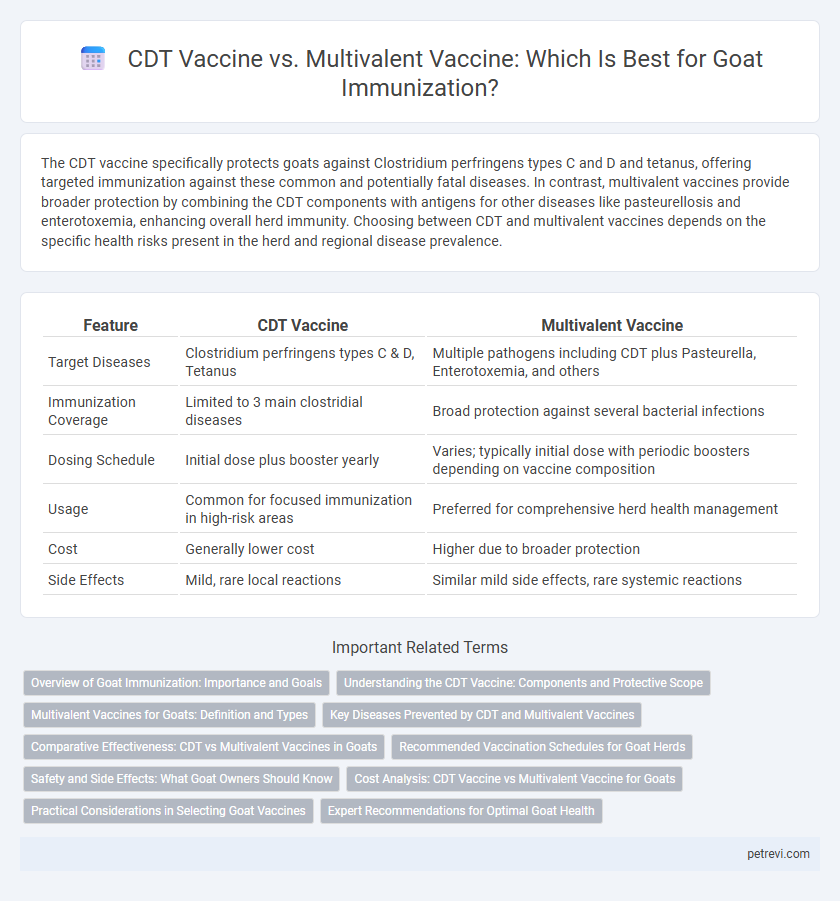The CDT vaccine specifically protects goats against Clostridium perfringens types C and D and tetanus, offering targeted immunization against these common and potentially fatal diseases. In contrast, multivalent vaccines provide broader protection by combining the CDT components with antigens for other diseases like pasteurellosis and enterotoxemia, enhancing overall herd immunity. Choosing between CDT and multivalent vaccines depends on the specific health risks present in the herd and regional disease prevalence.
Table of Comparison
| Feature | CDT Vaccine | Multivalent Vaccine |
|---|---|---|
| Target Diseases | Clostridium perfringens types C & D, Tetanus | Multiple pathogens including CDT plus Pasteurella, Enterotoxemia, and others |
| Immunization Coverage | Limited to 3 main clostridial diseases | Broad protection against several bacterial infections |
| Dosing Schedule | Initial dose plus booster yearly | Varies; typically initial dose with periodic boosters depending on vaccine composition |
| Usage | Common for focused immunization in high-risk areas | Preferred for comprehensive herd health management |
| Cost | Generally lower cost | Higher due to broader protection |
| Side Effects | Mild, rare local reactions | Similar mild side effects, rare systemic reactions |
Overview of Goat Immunization: Importance and Goals
Effective goat immunization aims to protect against multiple infectious diseases, enhancing herd health and productivity. The CDT vaccine specifically targets Clostridium perfringens types C and D and tetanus, offering focused protection against major clostridial infections. In contrast, multivalent vaccines provide broader immunity by combining several antigens, reducing the number of injections and improving overall disease control strategies in goat populations.
Understanding the CDT Vaccine: Components and Protective Scope
The CDT vaccine for goats contains Clostridium perfringens types C and D antigens along with tetanus toxoid, offering targeted protection against enterotoxemia and tetanus. Its focused formulation induces strong immunity specifically against these pathogens, reducing the risk of sudden death and toxemia in goats. Compared to multivalent vaccines, which cover a broader range of clostridial diseases, the CDT vaccine provides efficient defense where targeted protection against these critical toxins is prioritized.
Multivalent Vaccines for Goats: Definition and Types
Multivalent vaccines for goats provide immunization against multiple pathogens in a single dose, enhancing protection efficiency and reducing vaccination frequency. Common types include those targeting clostridial diseases (such as CDT--Clostridium perfringens types C and D and tetanus), combined respiratory pathogens, and enteric infections. These vaccines are essential for comprehensive herd health management, offering broader immunity compared to monovalent or CDT-specific vaccines alone.
Key Diseases Prevented by CDT and Multivalent Vaccines
CDT vaccines specifically target Clostridium perfringens types C and D and Clostridium tetani, preventing enterotoxemia and tetanus in goats. Multivalent vaccines offer broader protection by covering multiple pathogens, including Clostridium species, Pasteurella, and foot-and-mouth disease, safeguarding goats against a wider range of infections. Selecting between CDT and multivalent vaccines depends on regional disease prevalence and the specific health management needs of the goat herd.
Comparative Effectiveness: CDT vs Multivalent Vaccines in Goats
CDT vaccines specifically target Clostridium perfringens types C and D and Clostridium tetani, providing focused immunity against enterotoxemia and tetanus in goats. Multivalent vaccines cover a broader range of clostridial diseases, including CDT components plus protection against other Clostridium species, enhancing overall disease prevention. Studies indicate multivalent vaccines offer more comprehensive protection, reducing the incidence of multiple clostridial infections, while CDT vaccines are preferred in regions where targeted clostridial outbreaks are prevalent.
Recommended Vaccination Schedules for Goat Herds
CDT vaccine and multivalent vaccines serve critical roles in goat herd immunization, with CDT targeting Clostridium perfringens types C and D along with tetanus, recommended for administration every 3 to 6 months depending on herd risk factors. Multivalent vaccines cover a broader spectrum of pathogens, including clostridial diseases and other bacterial or viral infections, typically scheduled biannually or annually based on regional disease prevalence and herd exposure. Vaccination programs should be tailored to herd health status, pathogen exposure risk, and veterinary guidance to optimize immunity and minimize disease outbreaks.
Safety and Side Effects: What Goat Owners Should Know
The CDT vaccine, targeting Clostridium perfringens types C and D and tetanus, is widely regarded for its safety profile with minimal side effects such as mild swelling or transient fever in goats. Multivalent vaccines, offering broader protection against multiple pathogens, may increase the risk of adverse reactions including injection site abscesses or allergic responses due to the combination of antigens. Goat owners should monitor their animals closely after vaccination and consult veterinarians to choose the most appropriate immunization strategy balancing efficacy and safety.
Cost Analysis: CDT Vaccine vs Multivalent Vaccine for Goats
The CDT vaccine typically costs less than multivalent vaccines for goat immunization, making it a more affordable option for small-scale farmers focused on clostridial disease protection. Multivalent vaccines, which cover multiple pathogens including clostridial diseases and pasteurellosis, have higher purchase prices but may reduce overall veterinary expenses by preventing several infections simultaneously. Cost-benefit analysis must consider herd size, disease prevalence, and long-term health management to determine the most economical vaccination strategy for goat herds.
Practical Considerations in Selecting Goat Vaccines
Selecting between CDT and multivalent vaccines for goat immunization requires evaluating disease prevalence, cost-effectiveness, and ease of administration. CDT vaccines specifically protect against Clostridium perfringens types C and D and tetanus, making them ideal in regions with high incidence of these infections. Multivalent vaccines cover a broader spectrum of clostridial diseases but may increase the risk of adverse reactions and require careful handling to maintain efficacy.
Expert Recommendations for Optimal Goat Health
Experts recommend the CDT vaccine as a targeted immunization against Clostridium perfringens types C and D and tetanus, ensuring effective protection against these specific, high-risk diseases in goats. Multivalent vaccines provide broader coverage, protecting against multiple pathogens including Clostridium species, pasteurellosis, and other common infections, making them suitable for comprehensive herd health management. Choosing between CDT and multivalent vaccines depends on farm-specific disease prevalence, risk assessment, and veterinary guidance to optimize goat health and productivity.
CDT vaccine vs Multivalent vaccine for Goat immunization Infographic

 petrevi.com
petrevi.com